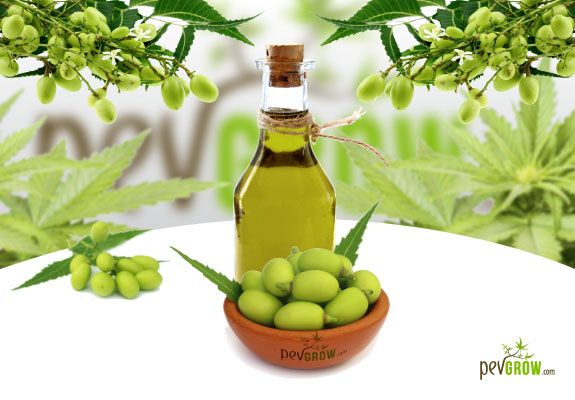

In constant struggle for the regulation of cannabis, mainly in the medicinal field.
21-07-2017 07:00:06 - Updated: 21 July, 2017
If you are one of those who wants to grow their marijuana plants in the most natural way possible, either outdoors or in indoor growing tents, neem oil is one of those basic products that should not be missing in your grow staff. Today we talk about Neem Oil origin, properties and uses to finish our post with the most common pests and other curiosities about this product. A product which is extracted from the tree that gives its name to the oil, the indian tree Neem.
Yes, I know. I’m sure you’ve heard many times about Neem oil, otherwise, probably you wouldn’t have stopped to read this post in our Pevgrow Blog. But I am also convinced that, although you know some things about Neem Oil, maybe you need to look into the last hints about Neem Oil applications, otherwise you wouldn’t be reading this post. I’m not mistaken, right?
A brief introduction
Of course, I am not trying to make this article into an encyclopedia or the great guide about Neem oil, but I would like to seize the following lines to share with you all things or at least many subjects that, over the years, I have been learning about Neem oil and also all the benefits its use brings us in the crops and, in particular, marijuana crop, which now is the most important to you and me, isn’t it?
Would you like to accompany me? I will love finally you do and I will like much more, that at the end of the text you can tell me, not only what you think, but also if you have something else to add or to correct, because it is clear that there are always concepts falling out of my hands and I would be glad to know them from your own hand, ans also you may have some doubts not answered yet regarding Oil Neem uses.Shall we begin then? Let’s go with the basics.
What is Neem Oil? Origin and properties
This oil, which is widely heard of, especially among those who are in favor of growing their plants in an organic way, owes its name to the tree from which it is extracted, in particular, from the Neem tree native of India, although today is grown in other countries with similar climates, ie tropical and subtropical.
In this regard, there are numerous countries in south America wherein we will find this tree, in fact, is also known on the other side of the Atlantic as Margosa or Lila India. Burma, in addition to India, as we said before, is another region in the world wherein you can see grow this type of tree that usually reaches 15 or 20 meters in height, although rarely can reach 35-40 meters .
When tree Neem blooms, their flowers are white beautiful colored and their fruit are slightly elongated as olive fruits, but somewhat longer (they can reach 28 mm long and 15 inches wide). Their color is yellowish and their flavor is a bit sweet, but it is not very pleasant in the mouth, at least not when it is in its purest state. So if you were wondering what does Neem oil taste like, I think I’ve just gave you an answer.

And, now that we have more data about Neem oil tree, we need to know where it comes from, even though I’ve just given you a clue. Indeed, this natural product is obtained from the fruits and seeds of that tree. Its most common use occurs in agriculture, but it is not the only one. We will also find Neem oil in natural and ayurvedic medicine, as well as in cosmetics or other sectors as we will see later.
But how is Neem oil extracted? There are two ways to do it mainly:
–Pressing and grinding the seeds and leaves of this tree, a process that can be made cold or hot. It is said that this is the most effective method for the oil to retain all its properties, especially if it is made hot. This would be the purest oil you can obtain, loaded with the majority of active principles of interest to us.
-By solvent extraction (industrial organic solvents, even though you can use non toxic solvets such as ethanol) from seeds and fruits. In case of using toxic organic solvents, you can diminish the quality of this method compared to we have mentioned before and its use is normally restricted to soap production.
The raw and clean extraction leaves us a by-product that is known as Neem powder. At PevGrow, in fact, we have this product in powder form and its use is ideal for: organic farming as a basis of preventive control of insects proliferation responsible of pests in the cannabis crop. In addition, this product does not leave waste in treated crops, so its use is very safe.
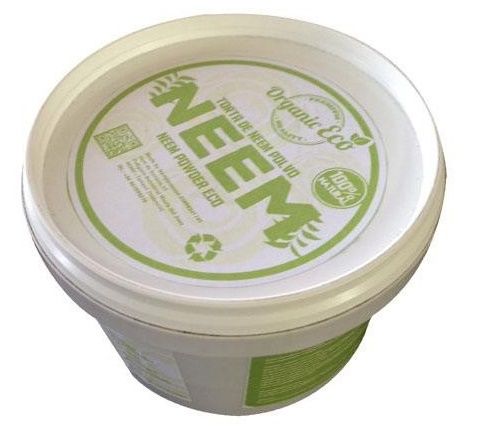
Returning to pure Neem oil, one of the ways to identify it is by its brown color on the one hand (the tonality can vary between the one that comes closer to yellow or orange and the one that has darker shades) and its strong aroma , on the other hand. In fact, experts say it smells like peanut and garlic. Curious mixture, right?
Although it is true that it is used in the country of origin within traditional medicine remedies, there are several studies that do not recommend their intake, in fact it is not a product for human consumption, but a phytosanitary product because it contains elements (active principles) in the composition that participate in its biocide action, helping those active principles to increase their activity.
In any case, what interests us most now is its use for our marijuana crops, and do not worry about its taste, since it will not affect the taste and quality of your final harvest if Neem is used correctly , respecting the security deadlines.
Yes, Neem oil is ideal to take care of your crop, mainly because it helps us to prevent and treat many cannabis pests, acting as a natural repellent in case of the pest has not occurred and as a natural insecticide in case we have not been able to control it before.
But what is really good is that its use carried out correctly does not affect people or animals, so it can be used both in indoor and outdoor cannabis crops, avoiding, as we said, the appearance or propagation of pests, especially insects such as whitefly, aphid, mealybugs, caterpillars, leafminers, thrips or red spider, among others, as well as can prevent the appearance of certain types of fungus which attack cannabis like mildew, botrytis or alternaria. It is recommended to blend pure neem oil with either potassium soap or sodium bicarbonate to promote fungicidal action.
As I said before, Neem oil has been used for centuries, mainly in agriculture, but in its country of origin is also used in traditional medicine and Ayurveda. And, although there are not many studies on the characteristics of this oil, its main properties are known: it is rich in Omega 3, 6 and 9. In particular, it is associated with antiseptic, antiparasitic and anthelmintic properties. In the same way, it is known that one of the main properties of the fruit from which this oil is extracted is that it is purgative.
But in addition, and here we speak of more scientific terms, which we find very interesting if we want to understand the benefits of its uses in our marihuana crop, is that neem contains more than 50 tetranortriterpenoids, being the best known and active Azadirachtin, which exerts an emetic action (induces vomiting and inhibits feeding) in the invasive insect.
Thus, Neem oil, unlike other industrial insecticides, does not directly kill insects or invaders that try to invade our crop, but prevents the insects from feeding, reducing the chances of their reproduction, so that finally or die or disappear. This prevents the pest from spreading, without forgetting that if they are trying to reach our crop already treated with neem oil, the mere smell of this oil will repel them. And all this being a product 100% natural without risk to human health. What else would you expect from this natural product?
Infographic about Oil Neem

Share this infographic on your website
[sourcecode language=”html”]
[/sourcecode]
How to use Neem oil?
In this case, there are two main ways: direct spraying and substrate irrigation. The first one is the most used and usually the most effective, but it is true that the second one is more effective in cases of specific pests such as, for example, whiteflies and sciarid flies. But let’s go one step at a time. We are going to focus on the direct spray method.
How to Spray with Neem Oil?
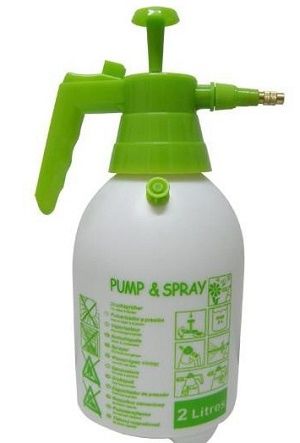
Very easy; You will need a sprayer, water, Neem oil (later we will talk about some products in particular) and potassium soap (or sodium bicarbonate).
Why use potassium soap for Neem oil?
Very easy; As you well know, water and oil can not be well blend, so to get them perfectly blended, we have to use a product that, without damaging our plant, helps us to make the blend and potassium soap (a natural insecticide in itself) is the best we can find, in addition it increases the pH which favors the fungicidal and insecticidal action.
And here you will tell me again. And Why Potassium soap? Because potassium soap, like Neem oil is a 100% natural insecticide, which besides help us to solve the product in water, also acts directly against certain types of pests, unlike oil, which is much slower. Therefore, we will have a product that is 100% natural and much more effective.
Type of spraying to be carried out
Well, now that you have all the material and methods, the next step to take into account is the type of spray that we are going to use or, rather, the objective that we want to fulfill with the use of Neem oil in our plant. These objectives are divided into three:
- As Wetting agent (initial preparatory use to know the tolerance of the plant), that is, to prepare our plant to the absorption of the active principles in this product. In this case and unless the product you hold in your hands hand indicates otherwise, you must use: 2 ml of oil per liter of water, besides to potassium soap, obviously. Spray every 12 to 14 days. The product will be absorbed by the plant, exerting a minimal systemic action, helping the its inmune system.
- As Preventive, as its name implies, to avoid possible pests. In this case the ratio is 4ml of oil per liter of water and it should be sprayed every 10 days. Although spraying always indicates contact with the pest, in this case we increase the dose to reinforce the preventive action of the product, taking into account that the plants have tolerated it perfectly.
- As contact Insecticide, in case you have noticed that your plant contains insects or fungi and you want to combat them, you must mix 8ml of oil per liter of water and spray every 7 days, although depending on the type of pest, you will have to do it every 3 or 4 days.
If you already have the product and no doubt about the use you want to give, you only must perform the following steps to spray your crop.
- Clean the plants before spraying, if possible, manually, to eliminate as many insects or eggs as possible.
- Spray the plant from all angles, both superior and lateral and do not forget the underside of the leaves , which is what many people forget when spraying, giving a result they did not expect, usually. Ideally go leaf by leaf and spray on both sides. Make sure there are no leaves covering among themselves being all them well wet. If necessary, make a second round of spraying.
- Repeat the process, at least, 1 or 2 times during the next 15 days, until you are sure that we have eliminated the pest that was damaging our crop.
In addition to these three points, other tips to keep in mind when it comes to spraying our marijuana plants with neem oil are as follows:
–To gear the ventilation to the plants (indoor crops), so that we avoid the creation of condensation bags between the leaves. This air will also generate troubles to any pest is going to be set in your crop. Of course, while you are spraying , switch the fans off for one or two hours until the leaves are well wet with the oil.
-When spraying, stir the sprayer steadily so that the mixture is always homogeneous.
-If you can, perform this spraying in low light, that is, at night or very early in the morning.
-Despite it is not toxic, NEVER spray the buds in advanced state of flowering, in case of having your plants at this phase, since Neem oil could affect the flavor besides exerting a negative effect on the Trichomes.
-We also recommend if you have furniture you love very close to your crop close or something you do not want to stain, remove it, because when sprayed, particles could fall on those objects.
And What if you want to irrigate on the ground because you have a fly pest on it?
In that case, you have to pour it into the plant roots and making the mixture act as a systemic insecticide, ie, the plant absorbs the Neem and accumulates it in plant tissues, also in this way, we can treat the plague by direct or contact method to all insects or fungi that proliferate from the substrate. In these cases, it is generally recommended to increase the dose, but it will depend on each provider. The best you can do is look well at the quantities indicated at the labels. If you are going to water, it will be enough to repeat the operation after 3 or 4 weeks. During that time it will be very important that you watch your plants well, so you notice that there is improvement or not.
In case of a thrips plague
Experts recommend doing two tasks: watering and spraying. So if the latter is your case … come on!
By the way, we have not mentioned it until now, but … did you know that Neem oil can treat pests to up to 200 types of insects and fungi. It’s fantastic!
Learn more about Neem’s tree with this video
How to make Neem Home Oil?
You know that in PevGrow we love to be handy, but as in this case we have only natural products to make life much easier, we will only pause at this point briefly.
What are you going to need?
A mortar, Neem tree seeds and water
The steps to take into account:
The steps to take into account are the following: put the seeds in the mortar and crush them. Little by little we will see how it is created a kind of sticky amalgam to which we will add olive oil, or if you prefer, paraffin liquid (more economic) in small quantities. You will see by yourself if you want it to be more or less thick. As simple as that.
But, of course, where to get those Neem seeds?
We recommend you to be much more practical and work with any of the products we have in our store. How much does Neem oil cost? Neem oil has a good quality/price ratio, between 12 and 15 euros approximately. At PevGrow we provide you with Neem oil for fungi and insect pests from AgroBeta, which contains the 3 most potent and abundant active agents of the seeds of Neem tree: Azadirachtin, Nimbin and Salanin. It’s 100% Bio.
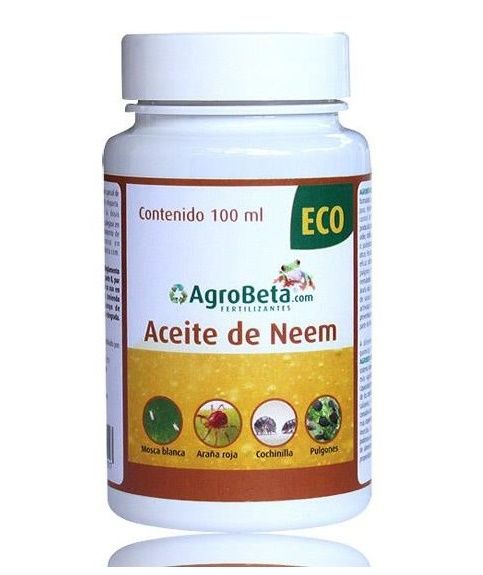
If this product does not convince you, we also have 100% Organic Neem Oil from Organik. It acts as a repellent and is effective against all types of mites, thrips, mealybugs and all coleoptera in general. As well as as the previous treatment model is rather preventive, this is ideal to end up the pests.
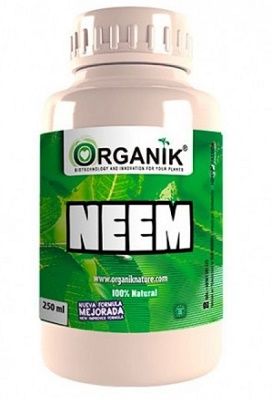
In both cases we must be able to dissolve the product well in water, to do that you know the use of potassium soap is always good. Here, we also offer two products: Organik Potassium Concentrate Soap, that, besides being an insecticide, will also help your plants grow stronger and healthier.

For its part, Potassium Soap Plant Clean from THC products , is ideal for cleaning your plants.
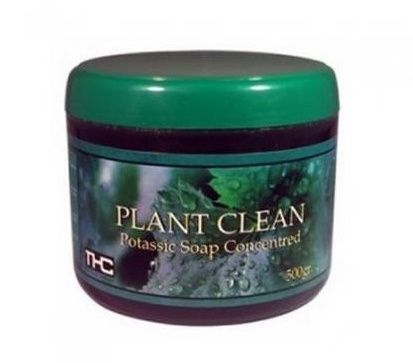
Other Neem Oil uses
As we said at the beginning, the main use of Neem oil is as a phytosanitary product, but it is also used in some countries (especially in India or wherein this tree grows) in a pure form as:
-Skin car products to treat eczema. In India and Bangladesh is used to make cosmetic products for hair, hand and body CBD creams, as well as for hand soap or washing clothes, also in Europe there are Neem extracts for cosmetic uses.
-In Ayurvedic medicine has also been used to reduce fever and inflammation.
-Spermicide (vaginally way of administration)
Conclusions
As you will have noted, Neem oil has many uses, but as far as we are concerned, that is, our marijuana plants, the most important thing is that this line of products are 100% natural and effectives without causing damages to our plants, in addition it’s a natural reinforcement for its defensive system against fungi and insects, besides acting as a contact biocide, it’s a very economical and easy to use product.
And now that you know all this, we encourage you to use it. Have you ever used it? Has it worked for you? Do you have a trick to share about it? Any question not answered yet? We’d love to hear from you!
By Noelia Jiménez, PevGrow Team





